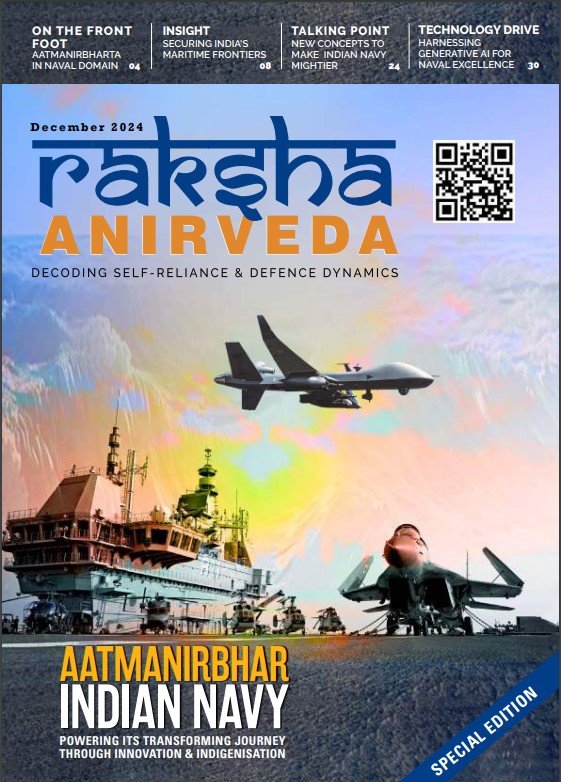The new term ‘disruptive technology’ refers to discoveries or innovations that significantly impact, alter, or transform industries, markets, businesses, or entire systems by introducing novel unthought-of methods, processes, or products that render existing technologies or commerce models obsolete. These technologies fundamentally change how things are executed, their new way of functioning often enhancing efficiency, reducing costs, easing out operations and offering quickest solutions.
The term ‘disruptive technology’ was first coined in the mid-1990s by Professor Clayton Christensen from the Harvard Business School. According to his theory, disruptive technologies typically overtake and overshadow the existing trends and processes in markets.
In the last two decades, novel technological ideas transforming into disruptive solutions, have gained momentum and militaries world over are seeking to adopt disruptive technologies in warfare since these technologies provide an overall edge in various realms of combat. Indian military needs to recognise, explore, adopt and adapt to disruptive technologies to gain edge over modern inimical forces and to avoid getting surprised in combat.
Some examples of disruptive technologies include Block-chain systems, Electric Vehicles, Artificial Intelligence (AI) and Machine Learning, Smartphones, Cloud Computing, Unmanned/Autonomous Vehicles, 3-D printing etc.
In warfare, the impact of disrupting technologies is wide-ranging, rapid and economical as highlighted below;
Efficiency and Effectiveness: Novel technologies often streamline operations, reduce human error, and enable faster decision-making. Automation can take over routine tasks, allowing human focus on more complex missions. Autonomous drones and robots can reduce the need for human intervention in dangerous or tedious environments, such as defusing bombs, rapid deployment or gathering intelligence.
The term ‘disruptive technology’ was first coined in the mid-1990s by Professor Clayton Christensen from the Harvard Business School. According to his theory, disruptive technologies typically overtake and overshadow the existing trends and processes in markets
Technological Superiority: Nations with superior technological capabilities have more leverage in both strategic and tactical military situations. By adopting disruptive technologies, a military ensures it maintains an upper hand.
Boosted Combat Capabilities: The autonomous systems, Artificial Intelligence (AI), and advanced weapons, can enhance the effectiveness and precision of military operations through AI’s predictive analysis of anticipation of enemy moves, targeting accuracy, minimising collateral damage etc.

Countering New Threats: As global threats evolve, militaries need to adapt with new technologies to counter emerging threats effectively. For example, cyberattacks have become a significant concern, requiring the military to invest in cybersecurity technologies and AI-driven defence systems. Likewise, advanced missile defence systems or counter-drone technologies are critical in addressing modern warfare challenges.
Asymmetric Warfare: Disruptive technologies can level the playing field in situations where one side has a clear numerical or traditional advantage. Smaller or less resource-rich nations may use advanced technologies like cyber warfare, drones, or precision-guided munitions to offset superior conventional forces, which shifts the nature of warfare and introduces new strategies for defence.
Operational Flexibility and Adaptability: Modern warfare is increasingly dynamic and unpredictable. Disruptive technologies – such as advanced communication systems, AI, and quantum computing – provide military forces with more flexible and adaptable tools. They can quickly reconfigure operations, improve intelligence-sharing, and optimise battlefield coordination, which enhances responsiveness to fast-changing conditions.
Strategic Advantage in Hybrid Warfare: Disruptive technologies often support hybrid warfare tactics, combining conventional military power with unconventional methods such as cyber warfare, disinformation campaigns, and economic pressure. By incorporating such technologies, militaries can better integrate these multi-dimensional approaches to modern conflict, creating more opportunities for asymmetric advantages.
Cost-Effectiveness: In the long term, some disruptive technologies can reduce costs by increasing efficiency. For example, unmanned systems (drones, robots) can replace more expensive human-operated machinery or personnel in hazardous environments. Additionally, technologies that enable remote warfare can reduce the need for large ground forces, potentially saving on personnel, logistics, and operational costs.
Global Influence and Deterrence: The adoption of cutting-edge technologies can enhance a nation’s global influence. Countries with advanced military technologies are often seen as leaders in global security and may hold significant power in international diplomacy. The mere potential use of these technologies can act as a deterrent, preventing adversaries from challenging the nation’s interests or engaging in aggressive actions.
Some examples of disruptive technologies include Block-chain systems, Electric Vehicles, Artificial Intelligence (AI) and Machine Learning, Smartphones, Cloud Computing, Unmanned/Autonomous Vehicles, 3-D printing etc
Emerging Disruptive Technologies
Indian armed forces, like many visionary strategic forces around the globe, must necessarily adopt emerging disruptive technologies to enhance its combat power, operational effectiveness, strategic deterrence, and regional influence. These technologies promise to transform the military’s role in both national defence and regional security. Some of the key emerging disruptive technologies in the military are:

Autonomous and Unmanned Systems; Unmanned Aerial Vehicles (UAVs), Unmanned Underwater Vehicles (UUVs), Autonomous Surface Vessels (ASVs): Undeniably, the role of unmanned systems in reconnaissance, surveillance, and intelligence gathering and in launching strikes is a huge tactical advantage. They significantly enhance situational awareness and reduce the risk of human losses in war.
Artificial Intelligence (AI) and Machine Learning (surveillance, decision support, predictive analysis & maintenance): Military systems with AI enhance decision-making process by analysing vast amounts of data from multifarious sensors grids to predict real time threats, improve strategic planning, and optimise resource allocation. They can also predict failures in combat assets, thereby enhancing preventive maintenance procedures to improve op-efficiency aspects.
Hypersonic Missiles and Advanced Weapon Systems: Hypersonic missiles (higher than Mach 5), are difficult to track, intercept and engage with, which makes them evade most potent missile defence systems, thus providing a great combat edge. The development of next-gen missile defence systems that can intercept hypersonic or ballistic missiles more effectively is also a key area of innovation. These systems use various technologies of advanced radar tracking, directed energy weapons and accurate, fast moving interceptor missiles.
Cyber Warfare and Cyber Defence: Cyber threats significantly affect strategic planning. Cyber-attacks can target critical military infrastructure, communications and weapons systems to jeopardise operations, as most systems are computerised & digitally interlinked. Hence, ensuring cyber security and launching offensive cyber warfare (disrupt adversary operations, disable command-and-control systems, or degrade enemy networks) are crucial.
Space-Based Technologies: Various satellites enable real-time monitoring of traffic, routes and detection of hostile movements or potential threats in areas of interest. They improve domain awareness and aid in security operations. It is important to own space assets to gainfully employ them in critical times.
Quantum Technology (Cryptography & Sensing): Quantum computing is set to revolutionise encryption and data processing, making military communication systems more secure against cyber-attacks. Quantum-based accurate sensors are enhancing underwater navigation and detection, especially in UUVs and submarine warfare.
Advanced Submarine Technologies (AIP, stealth tech): Air Independent Propulsion technology enables conventional submarines to operate for longer durations without surfacing, greatly enhancing their stealth and endurance. Highly advanced, versatile, stealthier submarines are difficult to detect. With novel hydrodynamic designs, materials and propulsion systems, these submarines can operate in contested regions without being easily identified.

Directed Energy Weapons (DEWs): These technologies offer the potential to neutralise threats at long ranges with high accuracy without the need for traditional munitions. The DEWs, (laser systems and microwave-based technologies) can effectively disable enemy sensors, drones, and missiles.
Biotechnology and Health Systems: Biotechnology advancements are enhancing the medical support during extended operations. Telemedicine, advanced diagnostics, and biological systems can improve crew health and safety, enabling sustained operations in isolated environments.
Swarming Technology and AI-Powered Drones: Swarming tactics involve the coordinated use of multiple small, much cheaper autonomous vessels/drones in multiple missions to overwhelm enemy defences. With AI, these drones/vessels work autonomously and cooperatively, making them harder to counter.
Essentially, adopting disruptive technologies in the military domain, offers significant advantages in terms of operational efficiency, strategic superiority, and enhanced defence capabilities. It ensures that the military remains ahead of potential threats and responds effectively to the rapidly developing modern combat scenarios. As these technologies further evolve, our operational readiness, deterrence capabilities and regional influence will only grow stronger and embracing these technologies will undoubtedly shape the future of India’s security.
–The writer is a former Indian Navy Submarine Officer. He is an underwater weapons and missile specialist and a deep sea diver. An alumni of DSCSC Mirpur, Dhaka, he has been Directing Staff of the prestigious DSSC, Wellington, Tamil Nadu and instructor at the Submarine Training Centre, INS Satavahana, Visakhapatnam. He regularly writes on military strategy, warfare and technologies. He is an active member of the Strategic Think Tank USI, STRIVE and the Chakra dialogues foundation. The views expressed in the paper are personal. He can be reached at sumit12in@gmail.com






